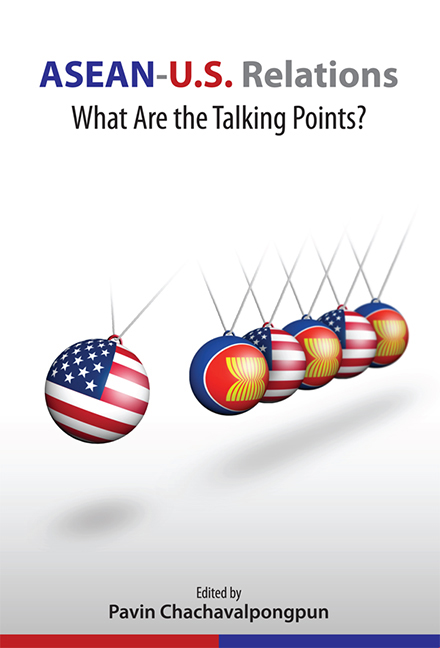Book contents
- Frontmatter
- Contents
- List of Tables and Figures
- Preface
- Contributors
- List of Abbreviations
- OVERVIEW
- 1 U.S. Engagement with ASEAN
- 2 ASEAN-U.S. Relations
- 3 Developments in ASEAN-U.S. Relations
- 4 The United States, Russia to be Part of East Asia Summit
- 5 How Does the United States Play into the East Asia Summit for ASEAN?
- QUINTESSENTIAL ISSUES
- Index
5 - How Does the United States Play into the East Asia Summit for ASEAN?
from OVERVIEW
Published online by Cambridge University Press: 21 October 2015
- Frontmatter
- Contents
- List of Tables and Figures
- Preface
- Contributors
- List of Abbreviations
- OVERVIEW
- 1 U.S. Engagement with ASEAN
- 2 ASEAN-U.S. Relations
- 3 Developments in ASEAN-U.S. Relations
- 4 The United States, Russia to be Part of East Asia Summit
- 5 How Does the United States Play into the East Asia Summit for ASEAN?
- QUINTESSENTIAL ISSUES
- Index
Summary
Members of the Association of Southeast Asian Nations (ASEAN) have agreed to invite the United States and Russia to participate in the region-wide forum, the East Asia Summit (EAS), which encompasses ASEAN Plus Six: Japan, China, South Korea, Australia, New Zealand, and India. The invitation immediately met with a favourable response from Kurt Campbell, U.S. Assistant Secretary of State for East Asia and the Pacific, emphasizing the United States’ renewed interest in its relations with Southeast Asia.
It is generally believed that United States’ participation will minimize China's increasing domination of the EAS. Long years of U.S. disengagement with ASEAN, particularly during the Bush administration, allowed China to take a leading role in ASEAN-led regional platforms. This situation coincided with the rise of China, both economically and militarily.
Over the years, China worked to erase its image as a threat. The popular catchphrase “China's peaceful rise” is frequently heard as Beijing does business with its Southeast Asian neighbours. But the territorial disputes in the South China Sea have effectively damaged this peace-loving image. The United States’ re-engagement with the region, through EAS, could be employed to counterbalance China's military might. In other words, the United States is needed and is urged to resume its Cold War role as a security guarantor for countries in Southeast Asia.
And what does China really think about the United States’ admission into the EAS? Madam Xue Hanqin, China's Ambassador to ASEAN, once provocatively asked, “Why do many Southeast Asians talk about the United States’ re-engagement with ASEAN when in fact the United States has never actually left the region?” Despite her sarcasm, China has at times signalled that it also wanted the United States “to be around” in the region, particularly to ensure that Japan remains “demilitarized”. Bitter history and mutual distrust remain forceful elements in Northeast Asian international politics.
- Type
- Chapter
- Information
- ASEAN-U.S. RelationsWhat Are the Talking Points?, pp. 21 - 24Publisher: ISEAS–Yusof Ishak InstitutePrint publication year: 2011



